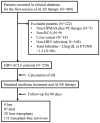Association between systemic immune inflammation index and short term prognosis of acute on chronic liver failure
- PMID: 39278977
- PMCID: PMC11402960
- DOI: 10.1038/s41598-024-72447-3
Association between systemic immune inflammation index and short term prognosis of acute on chronic liver failure
Abstract
The systemic immune-inflammatory index (SII) has been identified as an independent prognostic factor for multiple diseases. However, the impact of SII on outcome of acute-on-chronic liver failure (ACLF) is scant. A retrospective study enrolled patients with ACLF treated with artificial liver support system. Restricted cubic spline (RCS) (knots at the 10th, 50th, and 90th percentiles) and Cox proportional hazards models were applied to investigate the relationship between SII and 90-day transplant-free survival and overall survival in patients with ACLF. A total of 258 patients with ACLF were included. The 90-day transplant-free survival rate and overall survival rate were 58.5% and 66.3%. The SII was 465.5 (277.3-804.4). Adjusted RCS models showed linear exposure-response relationship between SII and 90-day transplant-free survival (P for overall < 0.001, P for nonlinear = 0.154) and 90-day overall survival (P for overall < 0.001, P for nonlinear = 0.103), and adjusted Cox models confirmed the positive relationship. Compared with patients with SII < 480, patients with ≥ 480 had more serious condition, lower 90-day transplant-free survival rate (46.8% vs. 69.7%, adjusted HR (95% CI) for transplant or death: 2.13 (1.40-3.23), P < 0.001), and lower 90-day overall survival rate (56.3% vs. 75.8%; adjusted HR (95% CI) for death: 2.26 (1.42-3.61), P = 0.001). Stratified Cox models suggested no potential modifiers in the relationship between SII and 90-day transplant-free survival. Our findings suggested SII was positively associated with poor short-term prognosis of ACLF.
Keywords: Acute-on-chronic liver failure; Artificial liver support system; Outcome; Risk factor; Systemic immune-inflammation index.
© 2024. The Author(s).
Conflict of interest statement
The authors declare no competing interests.
Figures





Similar articles
-
Association between lactate-to-albumin ratio and short-term prognosis of acute-on-chronic liver failure treated with artificial liver support system.Eur J Gastroenterol Hepatol. 2025 Mar 1;37(3):327-336. doi: 10.1097/MEG.0000000000002885. Epub 2025 Jan 29. Eur J Gastroenterol Hepatol. 2025. PMID: 39589807 Free PMC article.
-
Association between neutrophil percentage to albumin ratio and short term prognosis of acute on chronic liver failure treated with artificial liver support system.Sci Rep. 2025 Feb 11;15(1):5042. doi: 10.1038/s41598-025-89832-1. Sci Rep. 2025. PMID: 39934390 Free PMC article.
-
High Systemic Immune-Inflammation Index, Predicting Early Allograft Dysfunction, Indicates High 90-Day Mortality for Acute-On-Chronic Liver Failure after Liver Transplantation.Dig Dis. 2023;41(6):938-945. doi: 10.1159/000532110. Epub 2023 Jul 26. Dig Dis. 2023. PMID: 37494918
-
[Assessment Value of Short-Term Prognosis of Six Predictive Models for Patients with Acute-on-Chronic Liver Failure Treated with Artificial Liver Support System].Sichuan Da Xue Xue Bao Yi Xue Ban. 2022 Sep;53(5):758-763. doi: 10.12182/20220960203. Sichuan Da Xue Xue Bao Yi Xue Ban. 2022. PMID: 36224675 Free PMC article. Chinese.
-
Stabilisation of acute-on-chronic liver failure patients before liver transplantation predicts post-transplant survival.Aliment Pharmacol Ther. 2018 Jun;47(11):1502-1510. doi: 10.1111/apt.14627. Epub 2018 Apr 2. Aliment Pharmacol Ther. 2018. PMID: 29611203
Cited by
-
Association between the systemic immune-inflammation index and the outcome of liver fibrosis in patients with chronic hepatitis C.Front Med (Lausanne). 2024 Nov 26;11:1486503. doi: 10.3389/fmed.2024.1486503. eCollection 2024. Front Med (Lausanne). 2024. PMID: 39659620 Free PMC article.
-
Association between dietary selenium intake and the risk of cardiovascular disease in US adults: a population-based study.Sci Rep. 2025 Apr 18;15(1):13427. doi: 10.1038/s41598-025-97867-7. Sci Rep. 2025. PMID: 40251378 Free PMC article.
References
MeSH terms
Grants and funding
LinkOut - more resources
Full Text Sources

